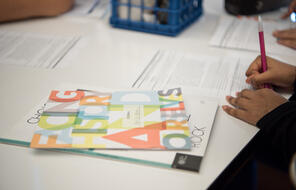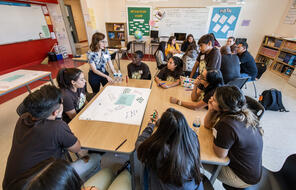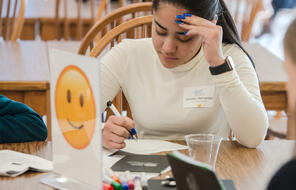Building Bridges through Culture
Stories passed down in Inuktitut, the Northeastern Canadian Inuit language, tell about the history and traditions of the Inuit, from child-rearing practices to uses of the land to dream interpretation. Other forms of communication, including dance, ceremonies, sacred objects, and singing, are also ways to pass on legacies. Such is the case for the tradition of throat-singing, or Katajjaq, that has been a part of Inuit culture for thousands of years. It is performed as a friendly singing competition between two women. The first person to laugh or stop singing loses. 1 The songs imitate sounds of nature, like the flow of water in a river. They also tell of ancestors’ everyday experiences—imitating, for example, the sounds of dogs panting as they pull sleds over ice.
Katajjaq is sometimes described as an “almost-lost” art form. It was banned alongside other Indigenous ceremonies and practices for decades, but it has re-surfaced in the last 20 to 30 years. 2 Karin Kettler and her sister Kathy are part of a revitalization of Katajjaq, performing throat-singing as the duo Nukariik, which means “sisters” in Inukitut. 3
Evie Mark is a well-known Inuit throat-singer and activist from Ivujivik. In an interview with Musical Traditions, Mark explains how important throat-singing has been for her:
There were a lot of elders who would throat-sing. It would amaze me. How could these two old women create such unique kind of, out of the world type, of sound? How could they create such spiritual sound? How can they do that? I want[ed] to learn too; so it became one of my goals, as a young girl.
… For me, it’s about identity, it’s about who you are, where your environment is. Throat-singing is strengthening my identity. The same thing with the youth. Even though I was raised by my grandparents, like a pure Inuk, some people in my community put me down because I was half-white. I wanted to prove them wrong. Now I realize I did not have anybody to prove to. But then, when you’re nine years old, ten years old, when you are being put down, it’s easy to believe in them.
Although I am half-white, I consider myself a true Inuk. But my white background allows me to share my culture to non-Inuit societies, like very English societies, French societies. I am able to say we are Inuit people, I am an Inuk person, this is where we come from. So I am able to share knowledge; I am able to say this is who we are. I have performed in many countries all over the world, in so many different places, hundreds of schools, different stages, in Montreal, all across Canada, Greenland, England, Denmark, and other places. 4
In many ways, Mark’s story is representative of her place within a generation of bridge-builders between Indigenous and non-Indigenous communities. Some believe that they can, in these ways, help point the way to a new understanding of Canada’s history and future.
Connection Questions
- According to Evie Mark, what is the importance of a cultural practice such a throat-singing? What is gained by reviving the tradition?
- What has throat-singing done for Evie Mark’s identity? How has it helped her both within and outside of the Inuk community?
- Do you and your family have any cultural traditions that have been passed down over time? How did you learn them? What do you know about their origins?
- What is gained from Mark’s sharing of her traditions with non-Indigenous people in Canada? In what ways is Mark an upstander?
- 1Bruno Deschênes, “Inuit Throat-Singing,” Musical Traditions, January 1, 2001. Throat-singing has a unique and extremely recognizable sound, but techniques do vary across the Inuit population. Generally, unlike melodic or harmonizing singing, Katajjaq has no notes and is based more on rhythm and tempo. Words are rarely used; instead, syllables without meaning and breathing techniques make up the music. See Alaska Dispatch News, October 23, 2013.
- 2Jackie Loohauis, “Sisters performing almost-lost art,” Milwaukee Journal Sentinel, September 6, 2003. See also “Inuit Throat-Singing,” The Magazine for Traditional Music throughout the World website, accessed September 19, 2014.
- 3Inuit Art Quarterly (Winter 2001), 15.
- 4Bruno Deschênes, Musical Traditions, January 1, 2001.
How to Cite This Reading
Facing History & Ourselves, “Building Bridges through Culture”, last updated September 20, 2019.
















